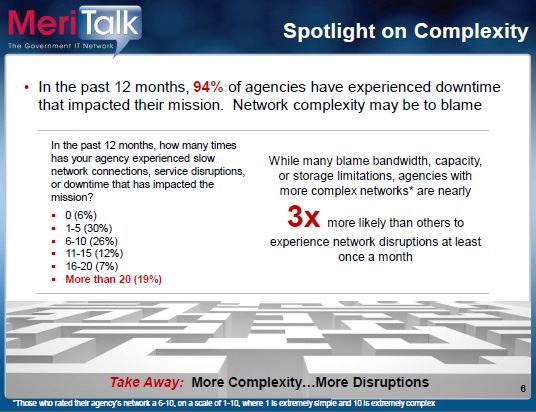Only a few days ago, the public-private partnership MeriTalk released a study that found that the U.S. federal government could save billions of dollars over the next ten years if it improved their management of copies of non-production data. Well the good folks at MeriTalk have released a new report, “The Federal Simplicity Report: Navigating Network Complexity,” that is sure to raise some eyebrows.
What is interesting is the study comes on the heels of SAP’s Sapphire Now show a few weeks ago where the message from SAP CEO Bill McDermott was “Make it Simple!” In fact, simplicity he stated was going to be the foundation upon which SAP would build its future success.
The MeriTalk study, underwritten by Brocade, reveals that Federal agencies with more complex networks are three times more likely to experience frequent disruptions than those with simplified networks, and 94 percent say they have experienced downtime that has impacted agency mission in the past 12 months. Respondents estimate that their agencies could save 18 percent of their IT budget, or $14.8 billion government-wide, by reducing network complexity by half.
While Federal IT managers know that reducing complexity is generally good for their agencies the trend is not their friend:
- 54 percent say their network complexity has increased in the past year
- 68 percent believe it will continue to increase over the next three years
The top factors contributing to this complexity boom include: increased network users (36 percent), the move toward server virtualization (33 percent), the move toward cloud computing (32 percent), and increased use of mobile devices, including BYOD (30 percent).


Source: MeriTalk, The Federal Simplicity Report: Navigating Network Complexity
As the authors of the study point out, the impact of this complexity are “quite serious.” Eighty-one percent of network managers believe that network complexity can slow or halt IT performance objectives, and 68 percent believe their complexity hampers their ability to implement new technologies, services, or capabilities.
Agencies agree that moving to open, non-proprietary standards is the most important step to reducing network complexity. Respondents note the varied benefits of a simplified network including improved network reliability, speed, security, streamlined maintenance, and improved IT agility to better support the mission.
“Reducing network complexity is a significant opportunity in Federal government data center transformation,” said Anthony Robbins, vice president Federal, Brocade. “Agencies must move toward open, non-proprietary standards to simplify their networks. The resulting networks should be designed for, and use, products from multiple vendors. This will create a more reliable, lower cost network which is set up to move in the direction of software-defined networking. This modernized network will then provide the IT agility required to better meet agency missions.”
In addition to moving to open standards, respondents suggested a few other ways to simplify their current networks. Cited were:
- Adding bandwidth (44 percent)
- Increasing redundancy (28 percent)
- Increasing virtual networking/software-defined networking (22 percent)
“The network is the road on which all government information travels,” said Stephen O’Keeffe, founder, MeriTalk. “Taking the road less traveled by – one with reduced complexity, interoperability, and diversification – will make all the difference, and is critical to agency performance and efficiency.”
For those looking at the results and seeing what appears to be a disconnect you have good eyes. On the one hand, the survey says that the move to virtualization and the cloud is what respondents believe is going to increase complexity. On the other hand, increased virtualization and SDN are seen as the way to reduce complexity. Reality is both points seem to be valid. If not done properly the move to the cloud can be disruptive on a series of levels and create complexity issues. That said, clearly the cloud solutions vendors understand this and are using next generation cloud-based solutions as the cornerstone for making getting to simple easier.
Given that the U.S. Federal agencies have been tasked with moving to the cloud sooner rather than later and doing so as the means to increase operational efficiency and effectiveness, the lesson to be gleaned here seems unmistakable, i.e., doing it right means taking complexity out of the mix.